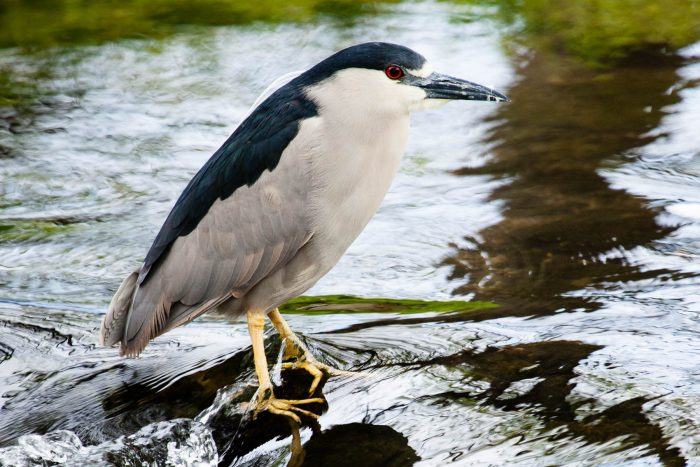Black-Crowned Night Heron
Nycticorax nycticorax
The black-crowned night heron is a small, stocky wading bird that lives year-round in marshes and wetlands throughout the Chesapeake Bay region.
This section shows one large critter image at a time. Use the thumbnails that follow to select a specific image to display here.

This gallery contains a grid of small thumbnails. Selecting a thumbnail will change the main image in the preceding section.
Appearance
The black-crowned night heron has a small, stocky body and grows to 23 to 28 inches tall, although it usually hunches its neck into its body. It has a white head with a glossy, black "cap"; a glossy, greenish-back; white or light gray underparts; and gray wings, rump and tail. Its bill is thick and black, it has red eyes, and its legs and feet are yellowish-orange. Males have two long, white plumes on the back of their head during breeding season. Juveniles are mostly brown with buff and white streaks on the head, chest, back and wings.
Feeding
The black-crowned night heron eats mostly small fish, amphibians, crustaceans and aquatic insects. It silently stalks its prey in shallow waters, then plunges into the water and grasps its prey in its bill. It feeds throughout the night to avoid competition with other herons.
Flight
When flying, the black-crowned night heron holds its bill straight ahead and its legs straight back when flying. Its stocky body and pale gray underparts are visible in flight.
Voice
The heron's call is a flat-sounding quok or quark, most often while flying or on a perch.
Reproduction and life cycle
These herons nests and breeds in colonies. The Bay’s largest breeding colony is on Fishermans Island at the mouth of the Bay. Other colonies are located near Baltimore Harbor, Mobjack Bay in Virginia, and on islands near Tangier and Pocomoke sounds. Breeding may begin as early as February; new breeders continue to arrive at the colonies through the end of April. Males perform several breeding displays to attract a mate.
The black-crowned night heron will build a platform nest of sticks in a tree. One tree can have more than a dozen nests in it. Females lay 3 to 5 eggs from mid-March to late April with most eggs hatching between late April and late May. The young fledge after about six weeks. Most herons leave the breeding colony between mid-August and October.
Did you know?
- If disturbed, young black-crowned night herons may regurgitate their food onto the intruder.
- Black-crowned night herons are most active at dawn or at dusk, and often spend the daytime hidden among foliage or tree branches.
- Breeding black-crowned night herons will raise any chick placed in their nest, not distinguishing between their own offspring and those from other parents.
Sources and additional information
- Life in the Chesapeake Bay by Alice Jane Lippson and Robert L. Lippson
- Animal Diversity Web: Nycticorax nycticorax – University of Michigan Museum of Zoology
- All About Birds: Black-crowned Night Heron – The Cornell Lab of Ornithology
- NatureWorks: Black-crowned Night Heron – New Hampshire Public Television
